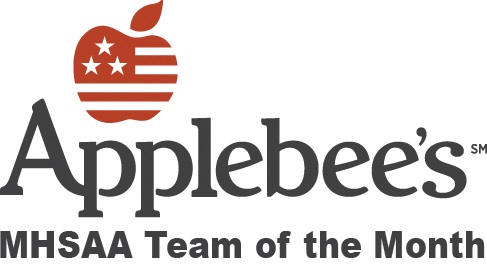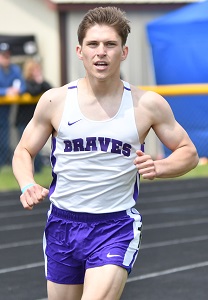
Full Team Effort Helps Gladstone Go Distance
June 19, 2019
By Geoff Kimmerly
Second Half editor
With Gladstone’s boys track & field team set to begin competition two months ago, longtime coach Gary Whitmer described his team in a local newspaper preview as a mystery.
 There were signs it could be a special spring, going back at least a year, when the Braves finished third at the Upper Peninsula Division 1 Finals thanks in part to then-freshman Calvin Thibault winning both hurdles races.
There were signs it could be a special spring, going back at least a year, when the Braves finished third at the Upper Peninsula Division 1 Finals thanks in part to then-freshman Calvin Thibault winning both hurdles races.
Whitmer also took notice at the end of the fall when his cross country team finished third in UPD1 – one point ahead of annual distance power Marquette – with Gladstone senior Adam Bruce the individual champion.
The Upper Peninsula Track & Field Finals can be a little bit different game than the championship meets downstate. But Gladstone’s boys solved all the mysteries and played the Finals game well. The MHSAA/Applebee’s “Team of the Month” for May won league championships in both the Great Northern and Mid-Peninsula Conferences, then claimed their Division 1 Regional before winning its first Finals since 2013 on the first day of June.
The Braves won with 127 points, 30 ahead of both Ishpeming Westwood and Marquette – the runners-up in Gladstone’s league title wins. The Braves also broke a four-year Finals winning streak for Marquette, the UP’s largest school with 950 students – twice as many as Gladstone’s 460.
“Downstate, you can come (to the Finals) with 4-5 really good athletes and win it, because there are so many schools,” Whitmer said. “But up here, if you don’t have the numbers … when you get in with Marquette and the Sault and bigger schools, you have a different strategy. You’ve got to get as many kids in there as you can.”
Gladstone had 40 athletes on its boys team this spring. Just fewer than half – 18 – qualified for the Finals during the Braves’ 24-point win at their May 16 Regional. Of that 18, 15 placed among the top six to score in their events at the June 1 Finals.
While Marquette has owned UPD1 over the last decade with seven titles since 2010, Gladstone was similarly dynastic winning six straight from 2004-09 and then again in 2013. But compared to that most recent previous champ, this Braves team enjoyed an important variety of talented athletes – with a boost from a comeback by one of the program’s best all-time.
 Bruce had hip surgery in January and didn’t start racing again until May. But whereas Gladstone didn’t place anyone in the 1,600 and 3,200 during the 2013 title run, Bruce won both races this time both at the Regional and Finals. He didn’t get up to speed to break his school records set in both in 2018, but still came through with 20 points at the championship meet and likely would have scored more if he’d run the 800 – the only event at this year’s Finals where Gladstone didn’t have a placer. Bruce was held out of that race to keep his still-recovering legs fresh for the others. He also didn’t run on the 3,200 relay, which without him still cut 25 seconds off its previous best to place third.
Bruce had hip surgery in January and didn’t start racing again until May. But whereas Gladstone didn’t place anyone in the 1,600 and 3,200 during the 2013 title run, Bruce won both races this time both at the Regional and Finals. He didn’t get up to speed to break his school records set in both in 2018, but still came through with 20 points at the championship meet and likely would have scored more if he’d run the 800 – the only event at this year’s Finals where Gladstone didn’t have a placer. Bruce was held out of that race to keep his still-recovering legs fresh for the others. He also didn’t run on the 3,200 relay, which without him still cut 25 seconds off its previous best to place third.
“I don’t think the kids think they could’ve done it,” Whitmer said of winning it all. “He kept encouraging them and gave them confidence there was that possibility.”
Thibault did repeat as winner in both hurdles races and took third in the 100 and second in the 200. Sophomore Blake Servant won the discus by more than five feet, and junior Luke Van Brocklin just missed breaking the school record in the 400 while finishing second in a fast, tightly-contested race. Senior hurdler/sprinter James McKnight and junior thrower Greg Chenier also placed in multiple individual events.
Also adding to the Braves’ championship score were senior Jake Strasler, juniors Louis Berube, Jarret St. John and Kyle Van Brocklin; sophomores Wyatt Madden, Lucas Hughes and Ethan Milam; and freshmen Giovanni Mathews and Hunter Potter.
Gladstone won all but one of its meets this spring – finishing behind Marquette in late April at an event that allowed unlimited entries. Sadly, the Braves had additional motivation as well this season after longtime athletic director and assistant coach Matt Houle died Nov. 9. He had coached since the mid-1980s and remained part of Whitmer’s staff since the latter took over as head coach in 2002.
Whitmer had planned to retire with Houle, but not this soon. He’s eager to continue working with the program they helped build, already excited about a strong distance runner coming up and his team’s improving field events.
“I’ll be 64 this year, my wife is a family physician up here, and all six of our kids went to Gladstone High School and graduated from here,” Whitmer said. “I’m just going to keep plugging away, and I enjoy it. We have a great bunch of kids.”
Past Teams of the Month, 2018-19
April: Garden City baseball – Read
March: Holland West Ottawa boys swimming & diving – Read
February: Lowell wrestling – Read
January: Farmington United gymnastics – Read
December: Warren Woods-Tower wrestling – Read
November: Rochester Adams girls swimming & diving – Read
October: Leland boys soccer – Read
September: Pickford football – Read
August: Northville girls golf – Read
PHOTOS: (Top) Gladstone poses with its championship trophy after winning the UPD1 Finals. (Middle) Adam Bruce finishes his title-winning run in the 3,200. (Photos by Cara Kamps.)

Hastings Relays Reigns as State's Oldest Continuous Track & Field Meet
By
Steve Vedder
Special for MHSAA.com
April 10, 2024
Bob Branch remembers dabbling in other sports, but his first love was always running.
 The Hastings High School graduate admits he could never hit a baseball, football didn't especially appeal to him and basketball was just another way to spend time with friends. But for Branch, now 93, there was always track. That's the sport where his fondest and sharpest memories remain. And if you're talking track, many of his favorite memories come from participation in the state's oldest continuous track meet, the Hastings Relays.
The Hastings High School graduate admits he could never hit a baseball, football didn't especially appeal to him and basketball was just another way to spend time with friends. But for Branch, now 93, there was always track. That's the sport where his fondest and sharpest memories remain. And if you're talking track, many of his favorite memories come from participation in the state's oldest continuous track meet, the Hastings Relays.
Always held in early April, the meet dates back to 1937 – a bygone time that saw the first hostilities of World War II, gas at 20 cents a gallon and a loaf of bread selling for a dime.
And at a dusty old track surrounding the county fairgrounds in Hastings, a small relay event that included a scattering of participants from a dozen high schools was taking its first tentative steps.
Branch recalls a time when kids would run home after track practice because there were no buses, inexperienced young coaches had little actual knowledge of running fundamentals, and athletes looked at the sport as an afterthought after spending most of their high school days playing football and basketball.
 For Branch, the relays were the ideal way to ease into the track season.
For Branch, the relays were the ideal way to ease into the track season.
"I just liked to run," said Branch. "I remember I anchored a relay with my brother, and it always seemed cold when we had that meet. I remember teams would come from all over and you saw a lot of good athletes. Everybody seemed to have someone who was really good. Track wasn't very popular at that time, but I have a lot of good memories from running."
The Hastings Relays, which has changed formats and even names during its nearly nine-decade history, would traditionally kick off the track season. The meet was originally held at a makeshift quarter-mile track which surrounded the town's fairgrounds and was part of the city's annual Hastings Carnival – the track would become the midway during fair time.
The meet eventually moved to Johnson Field when the football field was dedicated in 1949 and ballooned to as many as 50 teams at its peak in 1957. For more than seven decades it was known as the Hastings Relays and then the Hastings Co-Ed relays before becoming the current Hastings Invitational, with the latest edition scheduled for Friday.
Johnson Field had a cinder track before it became an all-weather surface in the 1980s. During a time long before computers would be used to organize meet heats in mere minutes, Hastings coaches of all sports – defined as "volunteers" by the athletic department – would meet on the Friday before competition to hash out events.
People associated with the meet still recall the camaraderie built on those long Friday nights, followed by working what would often become 10-hour meets. Steve Hoke has been involved since watching his father, Jack, who coached teams at 15 of the meets beginning in 1951 and also had run in the first Hastings Relays. Steve Hoke later competed in the Relays as well during the early 1970s before becoming an assistant track coach, later the Hastings athletic director and now a volunteer worker.
"It was always a huge deal," said Hoke, who said the meet began as a pure relay event before transitioning to its current team format in the 1990s. "I remember we'd line the track the night before, and all the coaches would come to the house to organize everything. There was a brotherhood.”
 If you quiz many of the fleet of volunteers who've worked the relays over the years, each has a different memory from the meet. While Hoke describes the brotherhood and Branch the outstanding competition, others remember weather and the time a thunderstorm wiped out the line markings on the cinder track, or waking up to find three inches of snow that caused a rare cancellation of the meet. Others recall the shock of moving from the cinder to all-weather track or using the meet as an early measuring stick of what it would take to qualify for the state meet. The real old-timers remember the meet disappearing for three years during World War II.
If you quiz many of the fleet of volunteers who've worked the relays over the years, each has a different memory from the meet. While Hoke describes the brotherhood and Branch the outstanding competition, others remember weather and the time a thunderstorm wiped out the line markings on the cinder track, or waking up to find three inches of snow that caused a rare cancellation of the meet. Others recall the shock of moving from the cinder to all-weather track or using the meet as an early measuring stick of what it would take to qualify for the state meet. The real old-timers remember the meet disappearing for three years during World War II.
Hastings native and Western Michigan grad Tom Duits was the state’s second collegian to break the four-minute mile when he ran a 3:59.2 at a meet in Philadelphia in 1978. Duits, who ran in three Hastings Relays, was in line to join the U.S. Olympic team in 1980 before the United States pulled out of the games due to tension with Russia.
Duits has his own memories of the meet and the competition he faced there.
"I remember sunshine and being excited to be competing again. There were all these athletes swarming around; it was an awesome display of talent," he said. "It was always one of the best meets we'd be in. You could pretty much see the level of runners who would be at state, which made it a big deal. It was always early, but you could tell where you stood. It was great exposure."
Hastings track star Wayne Oom competed in four Hastings Relays from 1984-87. One of his sharpest memories was the difference between running on a raw cinder track versus the far more comfortable all-weather surface.
"Those cinders would grind into your skin," said Oom, part of the Hastings school record in the two-mile relay. "But I think it helped us because when we'd go to other tracks, it seemed we would run faster. I remember how competitive it was, especially in the distances. There were some great runners."
While participants have their unique memories, so do coaches. Former Saxons coach Paul Fulmer remembers 2008 when his team finished first on the boys side of the meet while his wife, Grand Haven coach Katie Kowalczyk-Fulmer, saw her girls team win the championship.
 "I knew we were one of the favorites to win because we were usually near the top of our conference and Regional," he said. "But then Katie's team was pretty good, and it was cool for them to win too."
"I knew we were one of the favorites to win because we were usually near the top of our conference and Regional," he said. "But then Katie's team was pretty good, and it was cool for them to win too."
Fulmer, who coached Hastings from 1978-81 and then 1985-2010, said at least part of the meet's popularity was derived from a unique way of scoring. Instead of individuals earning points solo, participants worked in pairs. For instance, two athletes would combine their shot put or long jump scores. New events such as the 1,500 relay and sprint medley were added.
"We had a tradition of being the state's oldest meet, and that was a big deal," Fulmer said. "And we ran a good relay; that attracted teams too. We took a lot of pride in that.
"And we'd get quite a lot of people to come to the meet. We'd set up until like 9 or 10 p.m., and then we'd have a party with all the coaches on Friday night."
While the meet has stretched 87 years, Branch said early participants and current runners have one thing in common: a drive to win. Branch ran in an era when the popularity of high school track was in its infancy. Today some of the best all-around athletes at a school are involved in the track program. The relays span the nearly nine decades in between.
"The quality of teams has gotten better and better," said Branch, the 1947 Lower Peninsula Class B Finals champ in the 220. "And this has made for a better meet. We would get guys who played football or baseball kind of drift into track, and that made the sport better. I think people began to appreciate track because we'd get teams from all over.
"We went from not really knowing what we were doing to track being a good sport. Even then, I'm not sure we appreciated what we had. We really liked the Hastings Relays and always wanted to do well there. It became popular and quite an honor to do well. Those are the kind of things I remember."
PHOTOS (Top) Racers run at the Hastings Relays, with several more awaiting their turns to compete at the longtime meet. (2) The author wrote on the 50th anniversary of the Relays for the Hastings Banner nearly 40 years ago. (3) Past athlete, coach and athletic director Steve Hoke shows some of the Relays awards from the 1930s. (4) Tom Duits was one of the state’s biggest track stars of the 1970s and ran in three Hastings Relays. (Top photo by Dan Goggins, Hoke photo provided by Steve Hoke and Duits photos provided by Tom Duits.)

